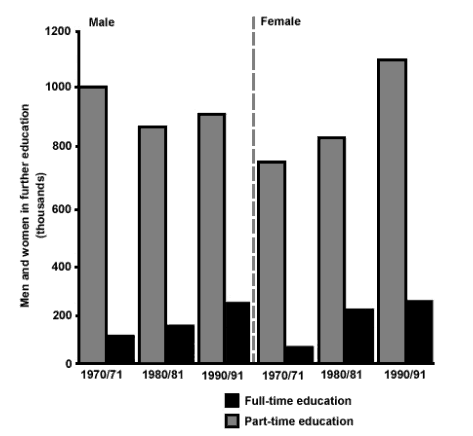
In last week’s post I gave a sample introduction and overview for this IELTS Task 1 Two-Sided Bar Chart. This week you can see my detail paragraphs.
The Two Detail Paragraphs:
Detail Paragraph 1: In regards to part-time education, male enrolment started in the 1970 school year at 1 million before dipping to around 850 thousand in the 1980 school year and making a slight recovery to around 900 thousand students in 1990/91. In contrast, females started lower initially at about 775 thousand and rose steadily, finally surpassing males in the 1990 school year for a final total of about 1,100,000.
Detail Paragraph 2: The trend for full-time education was only slightly different. Females numbers again started lower in the 1970 school year at under 100,000 students but had already surpassed male totals by 1980. From this period, females experienced slower growth than their male counterparts resulting in a matching final number of around 220 thousand students in the 1990-91 school year.
IELTS Master Explanation:
Notice how I organized the two paragraphs. Like the chart itself, I divided the detail paragraphs into full-time and part-time education. In each paragraph I wrote about the interesting trends for males and females. I organized it this way because I think the comparisons between males/females and between school years are more interesting than the comparisons between part-time and full-time.
Complete Essay (Band 9):
The bar chart compares the enrolment of men and women into full-time and part-time British further education programs in the 1970, 1980, and 1990 school years.
Overall, part-time education was several times more popular than full-time education throughout the entire period. In addition, while initially men had larger enrolment numbers in both part-time and full-time programs than women, by the end of the period women had surpassed men in part-time study and matched them in full-time.
In regards to part-time education, male enrolment started in the 1970 school year at 1 million before dipping to around 850 thousand in the 1980 school year and making a slight recovery to around 900 thousand students in 1990/91. In contrast, females started lower initially at about 775 thousand and rose steadily, finally surpassing males in the 1990 school year for a final total of about 1,100,000.
The trend for full-time education was only slightly different. Females numbers again started lower in the 1970 school year at under 100,000 students but had already surpassed male totals by 1980. From this period, females experienced slower growth than their male counterparts resulting in a matching final number of around 220 thousand students in the 1990-91 school year.
It was a great example to learn from
Happy to hear that!
Hi, can i say “women enrollment began ….” instead of saying “started”? thanks
Great work, but I wonder if there any synonyms to ‘ surpass’?
Good catch. I used “surpass” three times in the essay, a bit much. Instead, we could use “finally exceeding the number of…” in the second paragraph to mix it up.
Does not need a conclution paragraph in task 1?
That’s right. You don’t need a conclusion paragraph for Task 1.
Really great example for the task 1. I have learned a lot from this, especially some vocabulary words that you used.
thank you!
Is a pretty good one. Thanks ever so much, would be practising.
Great to learn such instance.
Im a teacher and this is a good example to compare with my students’ work.
This is the first online example that l found to be without mistakes.
CONGRATULATIONS